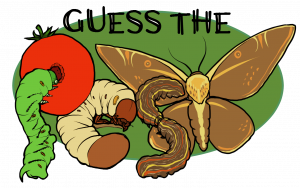
Bill Cissel, Extension Agent – Integrated Pest Management, University of Delaware; bcissel@udel.edu
Congratulations to Travis Kinnison for correctly identifying the damage in the photo as thrips injury and for being selected to be entered into the end of season raffle for $100 not once but five times. Everyone else who guessed correctly will also have their name entered into the raffle. Click on the Guess the Pest logo to participate in this week’s Guess the Pest challenge!
Guess the Pest Week #11 Answer: Thrips Injury on Soybean

Thrips are small bodied insects that use piercing-sucking mouthparts to feed on plants. The damage in the photo is of thrips feeding injury on soybean. The threshold for thrips is 8 per leaflet and leaf damage. However, we rarely reach populations high enough that the physical feeding injury warrants treatment. In fact, thrips are most known for their ability to vector plant diseases such as soybean vein necrosis disease (SVNd).

Adult Soybean Thrips
There are at least three species of thrips, including soybean thrips, which are capable of vectoring SVNd. From 2015-2017, we conducted a state-wide survey for SVNd, sampling 88 fields for thrips and disease symptoms. Our findings determined that the disease is prevalent in Delaware. We detected SVNd in 11.6% of the full season and 22.8% of the double crop soybean fields included in the survey averaged across all three years.
Here is a link for more information about the SVNd survey results,: https://cdn.extension.udel.edu/wp-content/uploads/2015/10/30120518/SVND-grower-summary-and-report.pdf

Soybean Vein Necrosis disease (SVNd) Symptoms.
Here is a link to a short Youtube Video Discussing SVNd symptoms:https://youtu.be/7gXDLjm5x7Q
Fun Entomology Fact: Thrips is the proper terminology used whether it is singular and plural. So you can have one thrips or many thrips.







